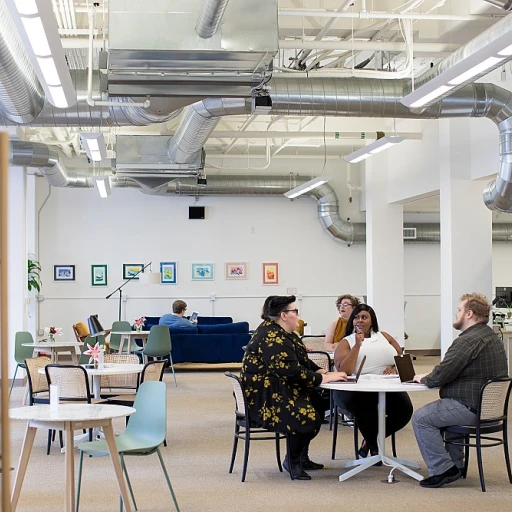
The Rise of Remote Nonprofit Work
The Expansion of Distance Opportunities in Nonprofits
The modern nonprofit landscape has witnessed a notable shift over recent years with the increasing prevalence of remote work opportunities. This change aligns with the broader global trend toward remote and hybrid remote work scenarios. Nonprofit organizations have embraced this transition, motivated by the desire to access a broader pool of talent and to offer greater flexibility to their teams. As a result, job listings for remote nonprofit roles have become more abundant, allowing professionals to contribute from various locales, including the United States and beyond.
Remote roles in the nonprofit sector span a range of positions, from social impact advisors to senior executives and development directors. These jobs offer varied opportunities to those seeking to make a meaningful difference without being constrained by geographical boundaries. The appeal of this work model is evident in the number of full-time and time featured remote nonprofit job openings, which have been posted across job boards dedicated to nonprofit careers.
The time-honored concept of physical workplace presence is undergoing a transformation. Organizations are rapidly adapting to the new normal where remote work is the standard, not the exception. This paradigm shift has unveiled numerous remote job opportunities across the nonprofit sector, appealing to those drawn to fostering social change while maintaining a desirable work-life balance. For nonprofits, remote work presents both opportunities and challenges, particularly in terms of maintaining consistent communication and coordination among team members.
The growth in the number of remote nonprofit jobs has underscored the importance of certain skills. For instance, professionals interested in these positions must be adept in communication, project management, and software development. Additionally, the role of a remote manager has become increasingly prevalent, focusing on the oversight of remote teams to ensure they meet strategic goals efficiently.
Overall, the rise of remote nonprofit work has unlocked a new era of possibilities, enabling individuals to contribute significantly to impactful causes from anywhere in the world. This trend is reshaping the workforce landscape, presenting new opportunities for organizations and job seekers alike. With ongoing developments and the influence of AI in human resources, this sector is set to evolve even further. For those interested in exploring how AI is transforming human resources in nonprofit organizations, check out this insightful exploration on AI-driven models.
AI's Role in Human Resources for Nonprofits
Unveiling the Benefits of AI in Human Resources
In recent years, the advancement of artificial intelligence has paved new pathways for nonprofit organizations, especially in human resources departments. The ability of AI to streamline processes offers noteworthy advantages to remote nonprofit work. Nonprofit organizations can employ these technologies to efficiently manage tasks that are traditionally time-consuming, ultimately saving significant time and resources.
One key area AI influences is job listings management. By utilizing AI-driven software, nonprofits can better handle remote job postings, leading to more accurate and timely job boards. This not only facilitates the hiring process for nonprofits but also creates additional opportunities for job seekers interested in remote positions.
In addition, AI enhances the candidate selection process for nonprofit jobs. Organizations can leverage AI tools to sift through numerous applications to identify top talents, allowing human resource managers to focus on more strategic tasks like employee development and retention strategies. Moreover, this enables a more inclusive and diverse workforce, aligning with the social impact goals of many nonprofits.
The ability of AI to optimize data also plays a critical role in HR departments. It provides senior managers and directors with data-driven insights necessary for informed decision-making. This extends to financial planning as well. Nonprofits can effectively allocate their budget to ensure funds are utilized in areas that yield the maximum social returns.
Organizations implementing AI solutions in their HR workflows not only enhance remote work efficiency but also improve their overall operational processes. As highlighted in this SHRM webinars blog, organizations can better understand how to integrate AI tools in human resources to further sustainable development goals.
Challenges in Implementing AI in Nonprofit HR
Overcoming Obstacles in Adopting AI for HR in Nonprofits
As the nonprofit sector increasingly embraces remote work, augmenting human resources with artificial intelligence presents both enticing possibilities and considerable challenges. Nonprofit organizations, eager to capitalize on these advancements, often find themselves navigating a complex landscape. Implementing AI in human resources is not as straightforward as it might seem, and nonprofits must address specific hurdles unique to their sector.
Firstly, many nonprofits operate under limited budgets, restricting their ability to invest in advanced technology. For an organization heavily focused on social impact, allocating funds to adopting AI tools can be a tough decision. With the rising number of job opportunities and growing demand for skilled remote workers, nonprofit organizations often encounter difficulties in aligning their financial strategies with tech investments necessary for maximizing remote work efficiency.
Another significant obstacle is the existing infrastructure within these organizations. Nonprofits may lack the technological foundations required to integrate AI-driven software development smoothly into their human resources systems. The transition to AI requires an upgrade or modification of existing systems, which can be time-consuming and resource-intensive.
Moreover, the workforce within nonprofits, accustomed to traditional work environments, may resist transitioning to AI-enhanced systems. Training staff and ensuring they are comfortable with new technologies necessitates additional investment in human resources development. Such training ensures that staff across all levels—from senior executives to entry-level positions—can competently utilize AI tools in their daily remote work.
Additionally, concerns about data privacy and ethical use of AI, particularly in managing sensitive employee information or matters related to job listings and applicant tracking, pose significant risks. Nonprofit organizations must ensure compliance with data protection regulations while embracing AI to augment their HR operations.
Overcoming these challenges involves strategic planning and careful execution. By prioritizing foundational investments, fostering a culture of adaptability, and ensuring data protection, nonprofits can position themselves to take full advantage of AI tools in the remote work landscape.
AI Tools Enhancing Remote Work Efficiency
Revolutionizing Workflow Efficiency with AI Tools
AI tools are at the forefront of enhancing the efficiency of remote nonprofit work, offering a full array of solutions that streamline job management and boost productivity. Nonprofit organizations can now bridge geographical gaps and manage tasks more effectively, optimizing their operations in a remote setting. One of the key benefits AI introduces is the automation of repetitive tasks. By doing so, nonprofit managers can dedicate more time to critical and strategic activities such as fundraising and social impact initiatives. For example, AI-driven software development tools have significantly reduced the strain on IT departments, allowing teams to work full time on development projects without the constant pressure of minor troubleshooting. Moreover, AI tools facilitate better communication and collaboration among remote teams. Such tools not only help maintain seamless interactions among team members regardless of their location but also support hybrid remote models, encouraging increased engagement and teamwork. This is particularly beneficial for organizations looking to operate across the United States or even internationally. Organizations utilizing AI in their daily operations can also witness improvements in human resources tasks. AI software helps sort through job listings and applications at an unprecedented pace, ensuring that the right candidates are matched with their ideal remote nonprofit jobs. This is especially vital in public and social sectors, where positions like executive director or senior program manager demand a precise match of skills and experience. Access to AI-equipped job boards further provides nonprofit organizations with rich data insights and comprehensive job opportunities that can be harnessed to advance diverse missions. Leveraging these tools grants them a competitive edge in their quest to make social impacts that resonate beyond traditional boundaries. Through AI, remote nonprofit organizations not only find the catalyst for growth but also discover new opportunities to better their internal processes, meet their strategic goals, and deliver value to their communities effectively and efficiently.Skills Needed for Remote Nonprofit Jobs
Essential Skills for Success in Remote Nonprofit Roles
For those exploring job opportunities in remote nonprofit roles, adapting to the unique work environment is crucial. Remote nonprofit positions demand a distinct set of skills focused on organization, communication, and technological proficiency, which can be pivotal for anyone seeking to thrive in this field. Effective time management is a critical skill. With the shift to remote work, nonprofit organizations expect team members to be adept at managing their schedules. Being able to prioritize tasks and adhere to deadlines without constant supervision is invaluable. This is especially relevant in global roles, where time zones vary, impacting your daily routine. Communication skills are at the forefront of remote nonprofit work. Given the decentralized nature of these roles, the ability to convey ideas clearly and efficiently, whether in written or verbal form, is fundamental. Video conferencing tools like Zoom and communication platforms such as Slack are commonly used, making digital communication competence essential. Technological proficiency is also necessary. Many nonprofit jobs involve using software development tools and platforms that enhance social impact and job efficiency. Familiarity with cloud-based project management software and collaborative platforms is often required to ensure seamless integration into the team. Other traits like adaptability and resilience are key. These abilities allow individuals to respond to new challenges and changes in the work landscape promptly. Given the dynamic nature of nonprofits, employees may often find themselves shifting roles or duties rapidly. Furthermore, an understanding of nonprofit development is advantageous. While technical skills are vital, having insight into the nonprofit's mission, social impact goals, and organizational framework can set candidates apart. Whether you're in a senior position like an executive director or an entry-level role, aligning your work with the organization's vision is crucial. Lastly, as nonprofits in the United States and beyond continue to evolve, the rise of AI in human resources requires staff to be open to learning new technologies and adapting to AI-enhanced productivity tools. This ensures that nonprofit organizations can continue to leverage technology for remote work efficiency and social impact. Developing these skills not only opens more job listings and opportunities on job boards but also positions candidates for success in nonprofit remote roles.Future Trends in AI and Remote Nonprofit Work
Envisioning the Evolution of Remote Nonprofit Careers
The future of AI in remote nonprofit work is both promising and challenging. As technology continues to develop, nonprofit organizations are increasingly adopting sophisticated tools to optimize their processes and enhance their social impact. However, navigating this complex landscape requires adaptability and foresight.- Embracing Hybrid Models: Many nonprofits are shifting towards a hybrid remote model, which combines the best of office work and remote capabilities. This creates opportunities for job positions that were not feasible before, allowing organizations to tap into a wider talent pool from across the United States.
- Increased Use of AI Tools: Nonprofits will leverage AI to streamline operations, from scheduling meetings to managing donor databases. The right AI tools will be integral in enhancing efficiency, allowing nonprofit managers to focus on higher-level strategic initiatives.
- Demand for Diverse Skill Sets: With the rise of remote jobs, nonprofits are looking for professionals who are adaptable and possess skills in software development, data analysis, and digital marketing to fill their job listings.
- Social Responsibility and Impact: AI's role in reinforcing the social mission of nonprofits remains crucial. Organizations will prioritize tools and systems that align with their values, ensuring that technology supports their social justice goals.
- Job Opportunities Across Regions: There will be an increase in remote nonprofit job opportunities featured on job boards, offering roles such as executive director, development director, and senior manager roles. These positions will emphasize not just technical prowess, but also a commitment to the organization's mission.
- Continuous Learning and Development: As remote work becomes more embedded, nonprofit professionals will need to engage in ongoing development to keep abreast of new AI applications and changes in the remote work environment.












